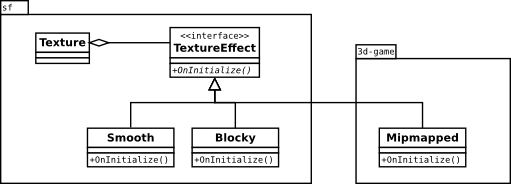My Game with 3D Graphic needs mipmapping and tilable textures and so. Theese are special usages of Textures, and I think adding a sf::Texture::SetMipmapped(bool) and sf::Texture::SetTilable(bool)
is not a very good design.
My ideas how to solve this:
1) Create my own Texture class for my game or a wrapper class:
- redundant Code
- much work
- my will probably get incompatible to nice SFML classes like RenderTexture
+ best control
+ no change in the SFML Library
2) add a virtual OnInitialize Function to sf::Textre in SFML 2.0
+ adding such special purpose effects becomes easy
- Textures you have not created by yourself (like the internal one in RenderTexture) won't have theese effects
- sf::Texture class has to be changed
=> not clean
3) add a callback OnInitialize to sf::Texture (in std::funtion<...> or even something like sigc::signal<...> style)
+ adding such special purpose effects becomes easy
+ special effects
- sf::Texture class has to be changed
- I can miss some textures
=> better than 2) but still not very clean
4) use Strategy-Design-Pattern for sf::Texture class this way:

(where Smooth has the same effect as sf::Texture with SetSmooth(true) and Blocky with SetSmooth(false))
+ adding such special purpose effects becomes very and flexible easy
+ clean evn the Texture::SetSmooth(true/false) idea gets a little cleaner
- sf::Texture class has to be changed
- big Design-Change
- large number of objects
- bindings for non OOP Languages will be nearly impossible
- far away to SFMLs usually clean Design
=> for me it looks the best way (flexible and clean)
5) just call sf::Texture::Bind() of the Texture and call my glTex... Stuff afterwards
- no way to find out whether a Texture has called glGenTextures internally in between - I have to take care of everything and can miss some changes of sf::Texture

- not very clean
+ most easy to way implement your Tetxure Parameter without altering SFML
6) add a public method in sf::Texture to find out whether the internal Textur has changed and combine with 5)
- absolutle not clean :shock:
Looks like there's no perfect solution.

What do you think? Do we need a change in sf::Texture? why? why not? Other ideas?
I didn't post this to the Feature Request Forum, because I want to discuss the different ideas with you folks.